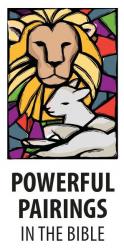
The book of Judges ends on this note: “In those days there was no king in Israel; everyone did what was right in their own sight.”
The former slaves in Egypt had been shaped in the desert of Sinai as they made their way to the Promised Land and, once there, had settled into tribal regions. Each region was ruled by judges whose primary responsibilities included protecting their people from perceived enemies and ensuring that God’s covenant with Moses remained intact.
However, these were chaotic times, and it seems that many had lost their way in the course of settling in. Israel told its ancient history with heroic exaggeration and brutal honesty. The tribal federation endured for a couple hundred years, but corruption led to moral confusion, and weakness fostered fear of losing traction among the nations that surrounded Israel. They began to clamor for a king.
In a sea of moral collapse (“everyone did what was right in their own sight”), a new story emerges of two women who live with deep regard for one another, illustrating with their lives the power of covenant love and righteous living. The book of Ruth tells the story of their devotion, and it stands in stark contrast to the relativism of the later judges of Israel.
Naomi and her small family had fled from Bethlehem in a time of famine. They crossed the Jordan River into the territory of Moab. Their sons married Moabite women, and in the way of a good short story, fortunes changed quickly. Naomi’s husband and her sons died, and when the women hear that Bethlehem’s fields are producing again, they make plans to travel and settle there.
One daughter-in-law, Orpah, heeds Naomi’s advice to stay with her family in Moab. The other, Ruth, continues on the journey, proclaiming that she will go where Naomi goes and adopt her people and her God, even to death. The story unfolds to illustrate that their devotion to survival and one another catches the attention of a distant male relative where Ruth faithfully gleaned the fields to provide for herself and her mother-in-law. Ruth’s steadfastness, even in hardship, and Naomi’s understanding of Israel’s culture and religious traditions, lead the male relative, Boaz, to marry Ruth and take responsibility for the two women.
It is a story of redemption amid need and faithfulness in the face of hardship. Though little mention is made of God’s law or the covenant in explicit ways, the entire stage of the story is permeated with a sense of God’s presence and provision. God provides for them in a time of famine and, in the end, provides for their future in the gift of a son born to Ruth and Boaz.
During mostly routine daily living in an agricultural community, Ruth and Naomi teach us that love and righteousness, hallmarks of God’s covenant, can be found right before our eyes and in the most mundane routines of daily living. Rather than doing what feels good or seems right in their own estimation, these women do what is right in the eyes of God, not for reward but in loving devotion.
Catherine Upchurch is the general editor of the Little Rock Catholic Study Bible and contributes to several biblical publications. She writes from Fort Smith.
Please read our Comments Policy before posting.
Article comments powered by Disqus Winning directory photo honors Our Lady of Guadalupe
Winning directory photo honors Our Lady of Guadalupe
 St. Paul says: How does the Bible define love?
St. Paul says: How does the Bible define love?
 6 steps to getting married in Diocese of Little Rock
6 steps to getting married in Diocese of Little Rock
 Most frequently asked questions on Catholic marriage
Most frequently asked questions on Catholic marriage
 St. Joseph a model of solidarity with immigrants
St. Joseph a model of solidarity with immigrants
 Two gifts after Jesus’ death: Virgin Mary and Eucharist
Two gifts after Jesus’ death: Virgin Mary and Eucharist
 Why we have an altar, and not just a communion table
Why we have an altar, and not just a communion table
 Pope: Wars should be resolved through nonviolence
Pope: Wars should be resolved through nonviolence
 Living relationship with Jesus Christ in the Eucharist
Living relationship with Jesus Christ in the Eucharist